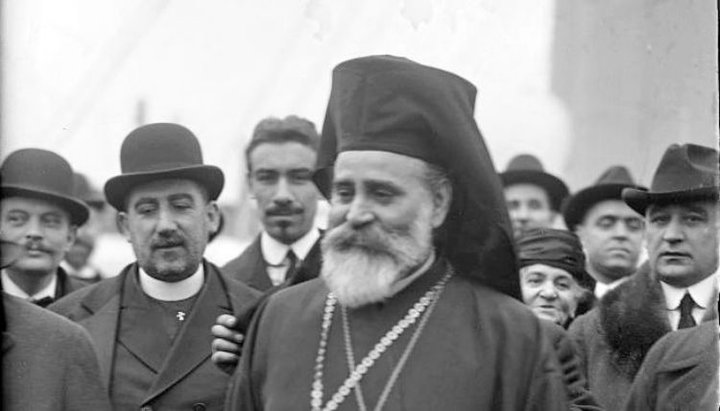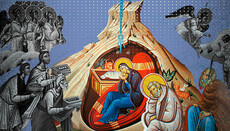On a short Tomos: how Phanar dealt with other Churches in the 20th century

Whom, how and why Patriarch Meletios (Metaxakes) of Constantinople granted autocephaly.
In the previous article we talked about the beginning of the life path of Patriarch Meletios (Metaxakes) of Constantinople, who was the first to lead his Church on an aggressive campaign in foreign countries against a foreign flock - the campaign, which contradicted and contradicts not only the canons and the Christian conscience but also common sense.
A man who as a deacon was first expelled from Jerusalem and then, as a metropolitan, – from Athens. All the more surprising is the fact that despite this he still managed to become the Patriarch of Constantinople.
In this article, we will describe how Meletios granted the first autocephaly to some Churches and was eventually expelled from Constantinople. After that, he, however, was still able to become the Patriarch of Alexandria.
Finnish autonomy
In the spring of 1922, Meletios addressed the head of the autonomous Finnish Church of the Moscow Patriarchate, Archbishop Seraphim (Lukyanov), with a proposal to grant autocephaly. Vladyka Seraphim refused.
Besides, Patriarch Meletios wanted to ordain Archpriest Herman (Aav) as bishop. Fr. Herman, to put it mildly, did not meet the canonical requirements of the Church. He was married twice, had 11 children, spoke about the canons of the Church contemptuously and believed that they had outlived their age long ago. That is why Vladyka Seraphim did not allow the ordination.
However, despite this, and without receiving the monk tonsured and rassaphore, Fr. Herman was ordained a bishop of Sortavala. Constantinople did it at the request and under pressure of Finland’s authorities.
On June 6, the Church of Finland, again, with the assistance of the state, was accepted into the jurisdiction of the Constantinople Patriarchate with the granting of ... autonomy, which it already had as part of the Moscow Patriarchate.
Vladyka Seraphim wrote a letter to the Patriarch of Constantinople, hoping to dissuade him from such a rash act. In particular, Vladyka wrote: “If they (representatives of the new Finnish Church – Ed.) see that the dependence is unpleasant and inconvenient for them, they will not hesitate to move away from this Church and, together with the “fraternal” Estonian Church, form self-originating autocephaly ... They need canonical connection with the Church of Constantinople only as a means of removal from the Russian Church and the achievement of complete freedom, when they are not constrained by anyone and when they tear up all spiritual unity with all other Churches and declare their canons in the spirit of the ‘Living Church’.”
Parallels with modern Ukraine suggest themselves.
Patriarch Meletios issued a decree according to which, during the Liturgy in the Church of Finland, the name of Patriarch Tikhon was to be commemorated immediately after the name of the Patriarch of Constantinople. The Finnish delegation promised to comply with this rule. However, very soon, Bishop Herman stopped commemorating the name of the Moscow Patriarch.
Again, a similar order was given to the head of the OCU Epiphany Dumenko, and for now he follows it. The question is how long it will last ...
The autonomy of the Czech Republic and Tomos for Estonia
On March 2, 1923, the Patriarchate of Constantinople issued the tomos “On the establishment of the Orthodox Archdiocese in the Czech Republic”. According to the document, the Czech Orthodox Church, which had previously been under the jurisdiction of the Serbian Church, received the same autonomy status, but already as part of the Constantinople Patriarchate.
Two days later, on March 4, 1923, Patriarch Meletios ordained Archimandrite Savvatij (Vrabec) as bishop and immediately appointed him head of the Czech Church.
Soon Meletios sent a letter to Archbishop Eulogius (Georgievsky), who pastored Russian parishes abroad. He demanded from Vladyka Eulogius complete and unquestioning obedience to the head of the Metropolitan Germanos of Thyatira. Naturally, the Russian bishop refused this demand.
On July 7, 1923, Archbishop Alexander (Paulus) of Tallinn and All Estonia departed for Constantinople, where he received the Tomos from the hands of Patriarch Meletios that the Estonian Orthodox Church became part of the Patriarchate of Constantinople as an autonomous church district.
The Moscow Patriarchate spoke against such a blatant violation of the canons. However, at that time the ROC was in such a terrible condition that no one paid any attention to its protest.
On the other hand, most likely, Patriarch Meletios would still accept the Czech, Finnish and Estonian Churches under the jurisdiction of Constantinople because he, like the whole patriarchate, was in a very deplorable situation and directly depended on the politicians of some European states.
On July 3, 1923, the Turkish government planned to expel Patriarch Meletios from the territory of the state. Moreover, it was not only about the patriarch himself but also about the patriarchate in general.
This became known in certain political circles who decided to seize the moment. Finnish Senator Eemil Setälä promised Meletios to postpone his deportation if he managed to arrange matters in the Finnish and Estonian Churches. As we already know, Meletios resolved the issue, and Setälä, using his diplomatic ties in Sweden, was able to influence the Turkish government and kept his promise – Turkey did not expel the patriarchate from the territory of the state.
Phanar and the "Living Church"
On August 24, 1923, Metropolitan Anthony (Khrapovitsky) wrote a letter to Patriarch Tikhon that the need for the existence of the highest ecclesiastical authority abroad was long overdue, since the Patriarchate of Constantinople began to extend its rights to "Poland, Estonia, Latvia and Finland, and even to the Chinese Ecclesiastical Mission". According to Vladyka Anthony, the Synod of Bishops of the Russian Orthodox Church will not only protect the property rights of the Russian Church, "but also help other autocephalous Churches to restrain the heretical innovations of some heads of autocephalous Churches".
Obviously, by the “heretical innovations”, the Russian bishop meant some ideas that were put forward by members of the so-called “Living Church”, which appeared at that time in the territory of the Soviet Union. The “Renovationists” (another name for the “Living Churches”) managed to quickly establish fairly close ties with the representatives of the ancient Eastern Churches. This is primarily about the Constantinople and Alexandria Patriarchates. Already at the First Congress of the Living Church in Moscow, Archimandrite Jacob (Patriarchate of Constantinople) and Archimandrite Paul (Patriarchate of Alexandria) sat on the presidium.
We should note in fairness that at first Patriarch Meletios did not support the “Renovationists” and even made statements in favour of Patriarch Tikhon. On April 24, 1923, the Holy Synod of the Church of Constantinople stated that "Orthodoxy regards the Patriarch of Moscow and All Russia as a confessor". However, despite this, the Patriarchate of Constantinople did not express a clear attitude to the “Renovationists”.
It was this ambiguous situation that allowed the “Holy Synod” of the “Living Church” on August 8, 1923 to address the Eastern Churches with the words: “We are faithful sons of the Holy Orthodox Church and never change the faith of our fathers and forefathers to any other new faiths and never tear away from the Orthodox East."
And the Soviet government decided to use the old method – to offer the building to the Phanar, which previously belonged to its representatives in exchange for a favourable attitude towards the “Renovationists”. On September 18, 1923, the Anti-Religious Commission of the Central Committee of the RCP (b) decided: “To instruct c. Popov (chairman of the commission – Ed.) to talk with c. Chicherin about the situation of Meletios and the Synod of Constantinople, and to return to their representatives the house in Moscow".
The house was returned ...
Istanbul Pan-Orthodox Congress
From May 10 to June 8, 1923, on the initiative and under the chairmanship of Patriarch Meletius, the so-called Pan-Orthodox Congress was held in Istanbul, which was attended by three people from Constantinople, one from Cyprus, one from Greek, one from Romanian and two from Serbian Orthodox Churches. Two Russian bishops who had no authority to represent the ROC also participated in the meeting – Archbishop Anastasius (Gribanovsky) and Archbishop Alexander (Nemolovsky).
The congress decided to carry out a number of reforms, including:
- Orthodox calendar reform;
- permission to the digamy of the clergy;
- admission to marriage after ordination;
- admissibility of the abolition of fasts (except Great Lent, Wednesday and Friday).
Archbishop Anastasius (Gribanovsky) did not sign any of these rulings.
Patriarch Meletios decided, at least at this level, to push through his new doctrine on the affiliation of the Orthodox diaspora with the throne of Constantinople. The Russian archbishop Alexander (Nemolovsky) categorically opposed such an initiative, saying that, for example, the transfer of Orthodox Christians in America from the jurisdiction of the Russian Church to the jurisdiction of the Patriarchate of Constantinople would be regarded as a betrayal of Patriarch Tikhon. The meeting participants agreed with the arguments of Vladyka Alexander and rejected the initiative of Meletios.
The All-Orthodox Congress adopted a resolution on the church situation in the Soviet Union. All the decisions of the “Renovationists” were recognized as non-canonical, and the Orthodox Churches called for every effort to be made to free Patriarch Tikhon. Perhaps it was this resolution that played a positive role in the case of the release of the Russian Patriarch from custody. The only positive role because world Orthodoxy decisively rejected all other proposals for reforming the Church, and Metropolitan Anthony (Khrapovitsky) generally called the calendar changes "an unreasonable and aimless concession to Freemasonry and papism."
Deposition and renunciation
Not only Orthodox bishops disagreed with church reforms of Meletios but the common people did not agree with them, which ultimately led to the deposition of the patriarch.
On June 1, 1923, i.e. even before the end of the Congress, followers of the priest Pope Eutymius and the believers outraged with the calendar reform staged a rally, which ended with an attack on the Patriarchate of Constantinople on Phanar. Protesters demanded to depose Meletios and expel him from Istanbul, the patriarchal chambers were trashed, and, according to press reports, the patriarch himself was “insulted by the action”, in other words, beaten up.
The government of Turkey demanded that Meletios transfer the patriarchal throne outside the state. The patriarch addressed his uncle, the ex-premier of Greece Eleftherios Venizelos in Lausanne, asking what to do. Venizelos replied that Meletius should leave the patriarchate. According to eyewitnesses, the patriarch was enraged, but on July 1 he followed Venizelos’s advice and settled on Mount Athos under the pretext of poor health. In his place, he left the locum tenens, who became Metropolitan Nicholas of Caesarea.
On July 24, 1923, in Lausanne, a peace treaty was signed between the allies (Greece, Britain, France, etc.) on the one hand, and Turkey on the other. According to the document, 1.6 million Greeks were deported to their homeland, as a result of which the Patriarchate of Constantinople lost almost all of its flock.
On October 2, the well-known priest Pope Eutymius mentioned in Istanbul, accompanied by his supporters and the Turkish police, entered the building of the Holy Synod of the Constantinople Patriarchate and demanded that the synodals depose Meletios (Metaxakes) within 10 minutes. Of the eight members of the Synod, only two opposed. Therefore, by a majority vote, Patriarch Meletios was removed from the primacy of the Church of Constantinople.
On October 12, the Greek government sent Archbishop Chrysostomos of Athens to Meletios in Thessaloniki (where he had settled by that time) to persuade him to renounce the patriarchate. Naturally, Metaxakes did not want to do this and considered his deposition to be invalid. However, under strong pressure from the authorities, who did not want the patriarchal throne of the Church of Constantinople to even be temporarily in the territory of Greece, on October 20, Patriarch Meletios (Metaxakes) still signed a renunciation of the patriarchate.
Two years later, Vladyka Meletios found himself in Egypt, where, with the help of the British, he became the Patriarch of Alexandria. He died on July 28, 1935, and was buried in Cairo.
The article uses materials from the book by M.V. Shkarovsky "Constantinople and Russian Churches in the Period of Great Upheavals (1910-1950s)", M, PH "Poznanie", 2019.











